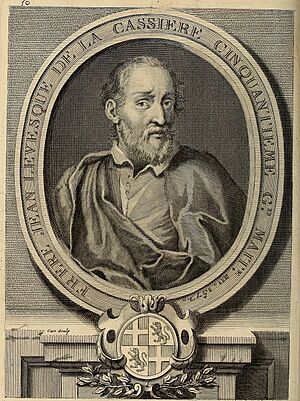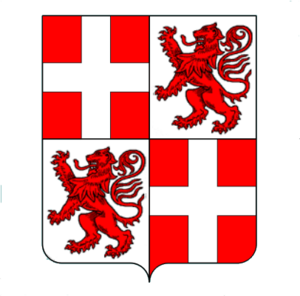Jean de la Cassière facts for kids
Quick facts for kids
Jean de la Cassière
|
|
|---|---|
 |
|
| Grand Master of the Order of Saint John | |
| In office 30 January 1572 – 11 July 1581 |
|
| Monarch | King Philip I |
| Preceded by | Pietro del Monte |
| Succeeded by | Mathurin Romegas (de facto) |
| In office October – 21 December 1581 |
|
| Preceded by | Mathurin Romegas (de facto) |
| Succeeded by | Hugues Loubenx de Verdalle |
| Personal details | |
| Born | 1502 Auvergne, France |
| Died | 21 December 1581 Rome, Papal States |
| Resting place | St. John's Co-Cathedral |
| Military service | |
| Allegiance | |
| Battles/wars | Great Siege of Malta |
Fra' Jean de la Cassière (born 1502, died 21 December 1581) was an important leader of the Order of Malta. This group was also known as the Knights Hospitaller. He served as their 51st Grand Master from 1572 to 1581. During his time, he ordered the building of a very grand church. This church is now called Saint John's Co-Cathedral in Valletta, Malta. He is buried there.
Contents
Becoming Grand Master
Jean de la Cassière was known for being very brave. He showed his courage in a battle in Northern Africa, where he saved the Order's flags. Before becoming Grand Master, he was a leader for the French-speaking knights from the Auvergne region. This group was called a Langue.
On January 30, 1572, he was chosen to be the new Grand Master. He took over from Pierre de Monte.
Challenges During His Rule
Jean de la Cassière's time as Grand Master was full of disagreements.
Disagreement with the Bishop
One big problem was with the Bishop of Malta, Martín Royas de Portalrubio. They argued about who had power over the church in Malta. The Knights Hospitaller had been given special rights when they arrived in Malta in 1530. They felt they had almost complete control. La Cassière could not fix this problem. So, the issue was taken to Pope Gregory XIII. The Pope then sent a special investigator, Pietro Dusina. La Cassière first supported this, but later, some knights felt it was an insult to their power.
Disagreement with Venice
Another major problem happened in 1575 with the Republic of Venice. The Knights' ships seized a Venetian ship that was carrying goods for Jewish owners. Venice was very angry about this. They threatened to take away all the Knights' property in Venice. Again, the Pope had to step in. La Cassière had to pay Venice a lot of money to solve the problem. Many knights were unhappy. They felt it was wrong to pay, as they believed they had the right to take property from non-Christians.
Disagreement with King Philip II
The most serious problem came from Philip II of Spain. He arranged for his young relative, 17-year-old Archduke Wenzel of Austria, to get an important position in the Order. This position was in the Spanish regions of Castile and Leon. The Spanish knights were furious about the king's interference. They openly rebelled against this decision. The Pope then ordered them to apologize publicly to La Cassière and the Order.
The End of His Rule
These problems made many knights angry with La Cassière. They felt he was causing all these difficulties. On July 11, 1581, the knights rebelled. They removed La Cassière from his position and locked him up in Fort St. Angelo.
After this, Mathurin Romegas became the leader. He was a famous naval hero of the Order. The Pope quickly sent a special messenger, Gaspare Visconti, to investigate. Both La Cassière and Romegas were called to Rome to explain what happened.
La Cassière arrived in Rome on October 26, 1581. The Pope treated him with great respect. Romegas, however, was treated very coldly. He died just a week later, on November 4, 1581. La Cassière was found innocent of all charges and was given back his title as Grand Master.
Sadly, he did not get to enjoy his victory for long. He died in Rome on December 21, 1581, at the age of 78. His body was brought back to Malta and buried in St. John's Co-Cathedral in Valletta.
Literature
Jean de la Cassière and the Battle of Zoara are featured in a book called Falcon's Shadow: A Novel of the Knights of Malta. It was written by Marthese Fenech in 2020. This is the second book in her series about the Siege of Malta.


